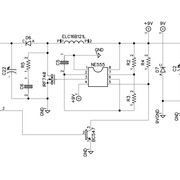Hi everybody,
I'm trying to "convert" a through hole layout to SMD and don't know what footprint to use with some components in a PSU. Could someone advise me please?
This is the PSU schem:

I'll be substituting resistors and caps with 0805 SMD footprint when possible (not the big electrolytics, of course). The components I don't know what hand solderable SMD footprint to use with are the following:
-100uH inductor
-7806 Voltage Regulator
-NE555 clock
-50mA self resetting polyfuse
-IRF740
Also, does anyone know what I could use to substitute these, please? They're for a cabsim.
BC547, BC337, BC327, TL072
Thanks a lot for your time and help
Cheers
Sono
When I do a conversion to SMD, I lay down dual footprints, so I can put on either. Sometimes thruholes in the SMD pads can suck away solder, it's worth it, and larger caps above 100uf can get quite large, so sometimes thru is better, especially with non-polar caps.
The 7806 regulator can have a footprint that includes the SMD heatsink and the large screw hole for the regular one. I make the hole in the PCB small enough that a 4-40 screw has to thread into the board, so it holds the regulator easily.





































